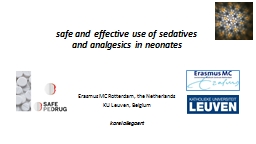

and analgesics in neonates Erasmus MC Rotterdam the Netherlands KU Leuven Belgium k arel allegaert SUGGESTION 1 Anand et al New Engl J Med 1987 Taddio et al JAMA 2002 Taddio ID: 999153
Download Presentation The PPT/PDF document "s afe and effective use of sedatives" is the property of its rightful owner. Permission is granted to download and print the materials on this web site for personal, non-commercial use only, and to display it on your personal computer provided you do not modify the materials and that you retain all copyright notices contained in the materials. By downloading content from our website, you accept the terms of this agreement.
1. safe and effective use of sedatives and analgesics in neonates Erasmus MC Rotterdam, the NetherlandsKU Leuven, Belgiumkarel allegaert
2.
3.
4. SUGGESTION 1
5.
6. Anand et al. New Engl J Med 1987Taddio et al. JAMA 2002 Taddio et al. Lancet 1995 and 1997
7. SUGGESTION 2
8.
9.
10.
11. Pacifici, Curr Ther Research 2015
12. oral routerectal routeBiodisponibility 0.54Anderson et al. Anesthesiology 1999 rectaal of oraal, 20 mg/kg single dose na NKO heelkunde
13. Ceelie et al. JAMA 2013opioid sparing effect in non-cardiac surgery, newborns
14. Pediatr Anesth, 2014‘minor’ pain syndromes
15. after procedural pain (heel prick), uniform negative ReferenceStudy design and pain modelParacetamol dosingResults Shah et al. Arch Dis Child Fetal Neonatal Ed 1998Double blind placebo controlled trial75 term neonates, heel prick.Facial action pain scores and cry score. Single oral paracetamol 20 mg/kg or placebo, 60 to 90 min before prick. No differences in facial action pain scores, nor in cry score.Bonetto et al.Arch Argent Pediatr 2008Prospective randomized trial76 term neonates, heel prickpain scores (NIPS, neonatal infant pain score>4)Placebo, dextrose (25%)EMLA or oral paracetamol (20 mg/kg, 60 min)NIPS<4 similar between placebo, paracetamol or ELMA (47, 42 and 63 %). Oral dextrose most effective (84% NIPS<4, NNT 2.7)Badiee et al. Saudi Med J 2009Randomized placebo controlled trial in 72 preterm (mean 32 weeks) neonates, heel prick PIPP (premature infant pain profile) scoreSingle (high dose) oral paracetamol (40 mg/kg) 90 minutes before prick. PIPP scores placebo (9,7, SD 4.2) were similar to paracetamol (11.1, SD 3.8)
16. the route of administration matters opioid sparing minor pain syndromes procedural painSUGGESTION 3
17.
18. please consider a loading dose when you anticipate continuous or repeated administrationSUGGESTION 4
19.
20.
21. extensive variability in practices between units (when, how, what)please consider a loading dose when you anticipate continuous or repeated administrationSUGGESTION 5
22. pediatrix datasets (US) (Clark et al, 2006; Hsieh et al 2014, Zimmerman et al, 2017) 1997-2004 2005-2010all casesmorphine 5.6 (19th) 7 (7th) %fentanyl 3.5 (25th) 5.1 (14th) % VLBW, ventilated 1997 until 2012 Opioids cont 5 % 32 % ventilation days
23. extensive variability between units 23 % of ELBW cases exposed to opioids, but 3 to 41 % 2.5 fold (range 919 to 2278/1000 neonates) Europain: extensive variability associated with prolonged ventilation in part explained by the respiratory support Canada and Europe (Borenstein-Levin et al, 2017; Carbajal et al, Lancet Resp Med 2015 ; Flint et al, 2018) prof B van Overmeire, La ventilation nécessite-t-elle une sédation systématique ?
24. less is more…?
25. assessmentpain scalesintersubjectivitytreatment maturational aspects unexplained variabilitypreventionrelevantlimitedindividualized approach
26.
27.
28. Paper in press, to be added (Pain)
29. assessmentpain scalesintersubjectivitytreatment maturational aspects unexplained variabilitypreventionrelevantlimitedindividualized approach
30. 0 60 120 minElectrical brain activity on aEEGCerebral oxygenation:NIRS determined rScO2Vital signsClinical scores:Relaxation, sedationPHARMACOKINETICSPHARMACODYNAMICSHeart rate Peripheral oxygen saturation Respiration rate Blood pressure%9060300 0 60 120 minDOSE FINDINGNr of patients21.510.50Propofol dose (mg/kg)ED50(µV)50251050Propofol blood concentrationminPropofol (ng/mL)euroanaesthesia london 28052016
31.
32.
33. pain/exitocytosisexposure to analgesicsapoptosis-synaptogenesis
34. SUGGESTION 5
35. Mind numbing: Anesthesia in baby rats stuntsbrain development.Common general anesthetics given at an early agemay cause brain damage and other neurologicproblems
36. Wilder et al. Anesthesiology 2009
37. de Graaf et al. Pain 2013 (8-9 year follow up after neonatal morphine)
38.
39.
40.
41. Wait and accept is not acceptableMieux vaut prévenir que guérirParacetamol: opioid sparing and minor, YESHow to give: loading doseWhen to give: extensive variability What to give: needs further study (dose seeking)Safety/toxicity remains a relevant issue